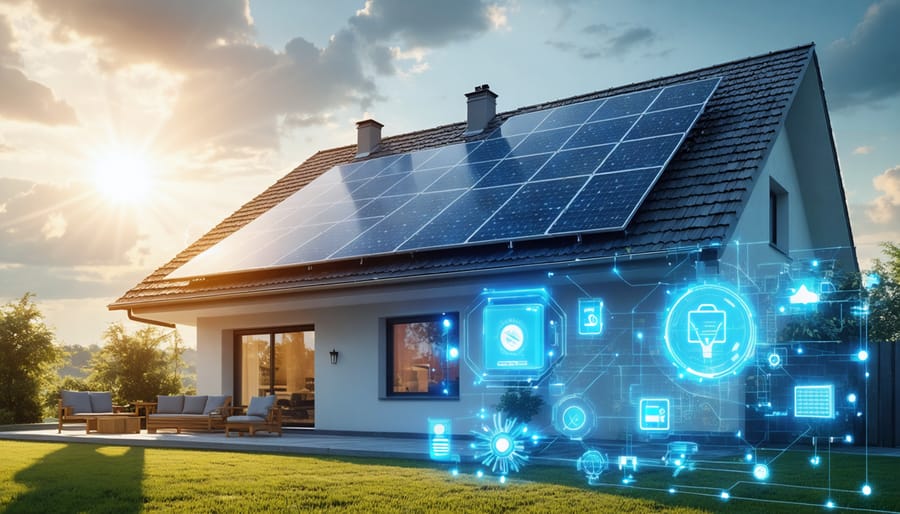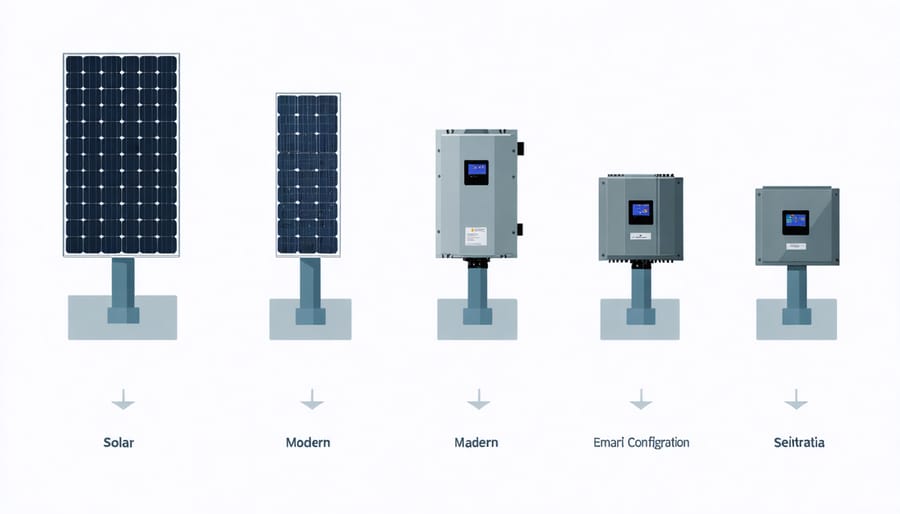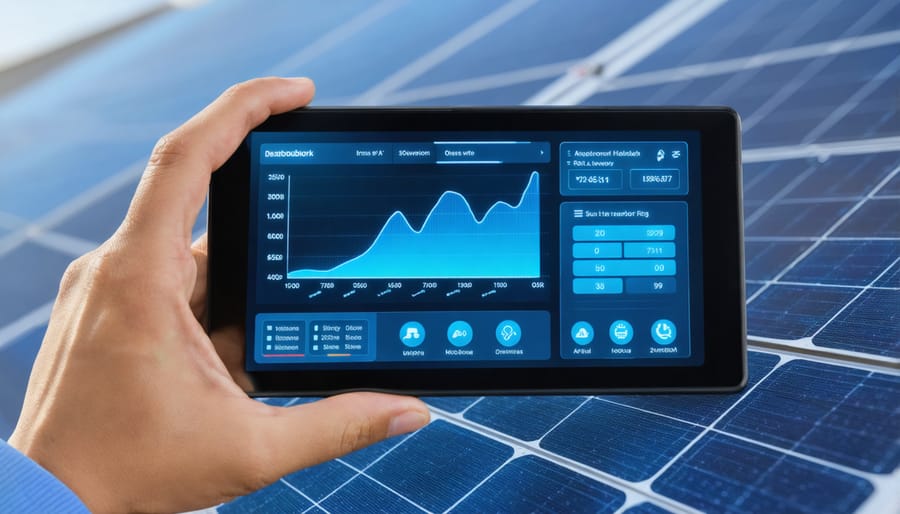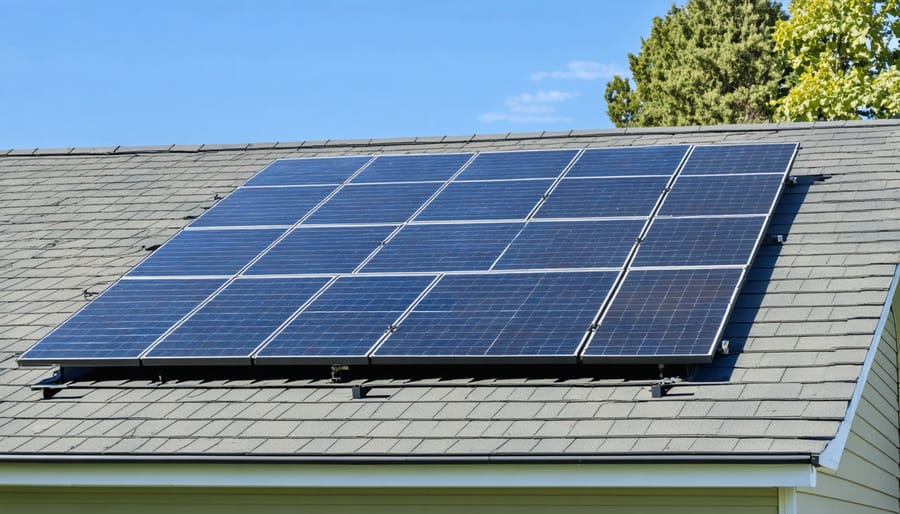Smart Solar Storage: How Modern Inverter Battery Systems Are Revolutionizing Home Energy

Transform your home’s energy landscape with modern smart solar storage solutions that seamlessly integrate solar panels, inverters, and battery systems. This revolutionary technology combination now delivers unprecedented control over household energy consumption while ensuring reliable power supply during grid outages. As Europe accelerates its transition to renewable energy, solar inverter battery systems have emerged as the cornerstone of sustainable power management, offering up to 90% energy self-sufficiency for properly equipped properties.
Through intelligent power conversion and storage capabilities, these systems optimize solar energy harvesting during peak production hours and efficiently distribute stored power when needed most. The latest generation of solar inverter battery systems features advanced monitoring capabilities, allowing users to track energy flows in real-time and automatically adjust consumption patterns for maximum efficiency.
Whether for residential installations or commercial applications, modern solar storage solutions represent a significant leap forward in renewable energy technology, combining high-performance batteries, sophisticated power electronics, and smart energy management systems into a cohesive, future-proof investment in energy independence.
The Evolution of Solar Storage Technology
From Simple Conversion to Smart Power Management
The evolution of solar inverter technology represents a remarkable journey of innovation in renewable energy. Starting from basic DC to AC conversion devices in the 1990s, inverters have transformed into sophisticated power management systems. Early models focused solely on converting solar-generated DC power into grid-compatible AC power, offering basic functionality with limited efficiency.
The 2000s marked a significant shift with the introduction of smart monitoring capabilities and improved efficiency ratings. European manufacturers pioneered many breakthrough technologies, including transformerless designs that reduced size while increasing performance. By the 2010s, hybrid inverters emerged, integrating battery storage capabilities and enabling greater energy independence.
Today’s solar inverter systems feature advanced power optimization, intelligent grid interaction, and seamless battery integration. Modern units offer remote monitoring, predictive maintenance, and dynamic power management. These systems can automatically adjust to varying energy demands, optimize battery charging cycles, and even participate in grid services, showcasing how far the technology has evolved from its simple conversion roots.
This technological progression has made solar energy systems more efficient, reliable, and accessible for both residential and commercial applications across Europe.

Key Innovations in Modern Systems
Modern solar inverter battery systems have witnessed remarkable advancements, introducing advanced storage technologies that significantly enhance system performance and user benefits. Smart monitoring capabilities now enable real-time system oversight through mobile applications, allowing users to track energy production, consumption, and storage patterns with unprecedented precision.
Integration with home automation systems has become seamless, featuring intelligent load management that automatically prioritizes energy use based on availability and demand. Newer systems incorporate bi-directional power flow capabilities, enabling vehicle-to-grid (V2G) functionality where electric vehicles can serve as additional storage units.
Enhanced safety features include advanced thermal management systems and sophisticated fault detection algorithms that protect both the equipment and users. The introduction of modular designs allows for easier system expansion and maintenance, while improved power conversion efficiency, often exceeding 98%, maximizes energy utilization.
These innovations have made solar storage solutions more reliable, efficient, and user-friendly, contributing to their growing adoption across European households and businesses.
Smart Integration Features
AI-Powered Energy Management
Modern solar inverter battery systems are increasingly leveraging artificial intelligence to revolutionize energy management. At the heart of these systems are sophisticated battery management systems that utilize machine learning algorithms to optimize energy storage and consumption patterns.
These AI-powered systems continuously analyze multiple data points, including weather forecasts, historical usage patterns, and real-time electricity prices. By processing this information, they can make intelligent decisions about when to store, use, or sell excess solar energy. For instance, the system might automatically store more energy when forecasts predict cloudy weather or increase grid export during peak pricing periods.
The AI components also enhance system longevity by monitoring battery health and adapting charging cycles accordingly. They can predict maintenance needs, prevent potential issues, and optimize battery performance based on environmental conditions and usage patterns.
For European households and businesses, this intelligence translates into tangible benefits. Users can achieve up to 25% higher energy efficiency compared to traditional systems, while reducing their carbon footprint. The AI additionally provides predictive insights through user-friendly interfaces, enabling property owners to make informed decisions about their energy consumption and storage strategies.
As these systems evolve, they’re becoming increasingly adept at integrating with smart home devices and supporting grid stability through intelligent load management, making them a cornerstone of Europe’s sustainable energy future.
Remote Monitoring and Control
Modern solar inverter battery systems incorporate advanced remote monitoring capabilities that transform how users interact with their energy systems. Through dedicated smartphone apps and web portals, system owners can track real-time power generation, battery status, and energy consumption patterns from anywhere with an internet connection.
These intelligent interfaces provide detailed insights into system performance, including battery charge levels, grid import/export data, and solar production metrics. Users can receive instant notifications about system status changes, potential issues, or maintenance requirements, ensuring optimal performance and swift problem resolution.
The control features allow users to adjust system settings remotely, optimizing energy usage based on time-of-use tariffs or weather forecasts. For instance, users can prioritize battery charging during off-peak hours or adjust power flow settings to maximize self-consumption of solar energy.
Many European manufacturers now offer integration with smart home systems, enabling automated responses to energy availability and pricing signals. This connectivity extends to virtual power plant networks, where multiple systems can work together to support grid stability and participate in energy markets.
For businesses and industrial users, these platforms often include advanced reporting tools and APIs for integration with building management systems, supporting comprehensive energy management strategies and compliance with European energy regulations.

Grid Integration Capabilities
Modern solar inverter battery systems excel in their ability to seamlessly integrate with smart grids, offering sophisticated features that enhance both system efficiency and grid stability. These systems can intelligently communicate with utility networks, enabling dynamic power management and response to grid conditions in real-time.
Advanced grid integration capabilities include frequency regulation, voltage support, and demand response functionality. During peak demand periods, these systems can automatically switch to battery power, reducing strain on the grid while optimising energy costs for users. Conversely, when grid demand is low, the system can store excess energy for future use or feed it back to the grid when most beneficial.
For European users, these systems comply with strict grid codes and standards, including VDE-AR-N 4105 and EN 50549, ensuring safe and reliable operation. Many modern inverters feature sophisticated anti-islanding protection and power quality management, contributing to grid stability and safety.
Smart monitoring capabilities allow system owners to track energy flows, optimise self-consumption, and participate in emerging energy markets. Some advanced systems even offer predictive analytics, using weather forecasts and historical consumption patterns to optimise energy management strategies.
These grid integration features are particularly valuable in regions with high renewable energy penetration, helping to balance intermittent solar generation and maintain grid stability while maximising the economic benefits for system owners.
European Standards and Compatibility
In the European Union, solar inverter battery systems must comply with stringent standards that ensure safety, efficiency, and grid compatibility. The key regulation governing these systems is the Low Voltage Directive (LVD) 2014/35/EU, which sets comprehensive safety requirements for electrical equipment operating between 50 and 1000V AC.
Modern solar inverter battery systems are designed to meet the EN 62109-1 and EN 62109-2 standards, which specifically address safety requirements for power converters in photovoltaic systems. These standards ensure robust protection against electrical hazards, electromagnetic interference, and environmental factors.
Grid connection requirements in Europe are particularly demanding, with systems needing to comply with VDE-AR-N 4105 in Germany and similar national guidelines across other EU member states. These regulations ensure that inverter battery systems can respond appropriately to grid fluctuations and maintain stability.
Energy storage systems must also meet the IEC 62619 standard for safety requirements of lithium batteries, a crucial consideration as lithium-based storage becomes increasingly common in European installations. The European EN 50549-1 and EN 50549-2 standards further regulate the connection of generating plants to distribution networks, ensuring seamless integration with existing infrastructure.
Most contemporary systems feature smart grid capabilities that align with the European Network Code Requirements for Generators (NC RfG), enabling sophisticated grid support functions like voltage regulation and frequency response. This adaptability is essential for the growing renewable energy landscape in Europe.
Manufacturers now provide documentation packages that demonstrate compliance with these standards, making it easier for installers and end-users to navigate certification requirements. Regular updates to these standards reflect the evolving nature of solar technology and grid requirements, ensuring systems remain future-proof while maintaining the highest safety and performance levels.
Real-World Applications and Benefits

Residential Success Stories
Across Europe, homeowners are increasingly embracing solar inverter battery systems, with remarkable success stories emerging from various regions. In Barcelona, the Martinez family reduced their annual energy bills by 85% after installing a 10kWh battery system paired with their existing solar array. Their smart inverter automatically manages power flow, enabling them to maximize self-consumption even during Spain’s shorter winter days.
In Munich, the Weber household achieved complete energy independence during summer months with their innovative 15kWh storage solution. The system’s intelligent load management ensures their electric vehicle charging and home appliances operate primarily on solar power, while excess energy is stored for nighttime use.
A community project in Amsterdam demonstrates the scalability of these systems, where 12 neighbouring homes share a networked battery storage solution. This collaborative approach has resulted in a 40% reduction in grid dependency for the entire neighbourhood, while providing backup power during occasional outages.
In Stockholm, despite limited sunlight during winter months, the Andersson residence maintains 60% solar self-consumption year-round through their advanced battery storage system. Their inverter’s weather-predictive technology optimizes charging cycles based on forecasted solar production.
These success stories highlight how modern solar inverter battery systems are transforming home energy management across diverse European climates and usage patterns, delivering tangible benefits while supporting the continent’s renewable energy transition.
Commercial Applications
Solar inverter battery systems have proven their worth across various commercial sectors throughout Europe. Major retail chains like Carrefour and IKEA have implemented these systems in their stores, significantly reducing operational costs while advancing their sustainability goals. In the Netherlands, a large-scale warehouse facility achieved a 40% reduction in energy costs within the first year of installing a comprehensive solar inverter battery system.
Manufacturing facilities present another compelling use case. A German automotive parts manufacturer integrated a 500kWh battery storage system with their existing solar installation, enabling them to maintain production during grid instabilities and capitalize on energy arbitrage opportunities. The system pays particular attention to peak shaving, reducing their demand charges by approximately 30%.
Data centers have emerged as prime beneficiaries of this technology. A Finnish data center operator implemented a hybrid system combining solar panels with a 2MWh battery storage solution, ensuring uninterrupted power supply while reducing their carbon footprint. The installation serves as both a primary power source and an emergency backup system.
Agricultural implementations have also shown promising results. A Spanish greenhouse complex utilizes a smart solar inverter battery system to power its climate control and irrigation systems, achieving energy independence during daylight hours and maintaining optimal growing conditions through stored power during nighttime operations.
These commercial applications demonstrate the versatility and reliability of solar inverter battery systems across different industries, offering both environmental and economic benefits.
Modern solar inverter battery systems have revolutionized the way we harness and utilize solar energy, marking a significant step forward in Europe’s renewable energy transition. These integrated solutions have transformed from simple power conversion devices to sophisticated energy management systems that enhance grid stability and energy independence.
The impact of these systems extends beyond individual installations, contributing to the broader goals of energy sustainability and carbon reduction across European communities. With increasing grid integration capabilities and smart energy management features, solar inverter battery systems are playing a crucial role in stabilizing power networks and enabling a more resilient energy infrastructure.
Looking ahead, the future of solar inverter battery systems appears promising, with continuous innovations driving improved efficiency and functionality. Emerging technologies in battery chemistry and power electronics are expected to further reduce costs while increasing system performance and longevity. The integration of artificial intelligence and machine learning will enable more sophisticated energy optimization, leading to even greater energy savings and grid support capabilities.
As European nations push towards their renewable energy targets, solar inverter battery systems will remain at the forefront of the clean energy revolution. Their continued evolution will support the expansion of renewable energy adoption, facilitate the transition to smart grids, and help create a more sustainable energy landscape for future generations.
The combination of decreasing costs, improving technology, and supportive policies suggests that these systems will become increasingly accessible and integral to Europe’s energy infrastructure, benefiting both residential and commercial users while contributing to a greener, more sustainable future.
Leave a Reply